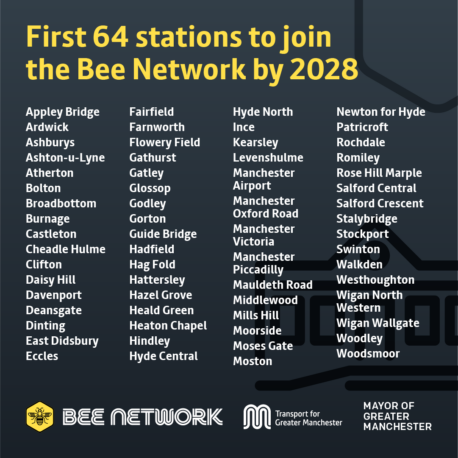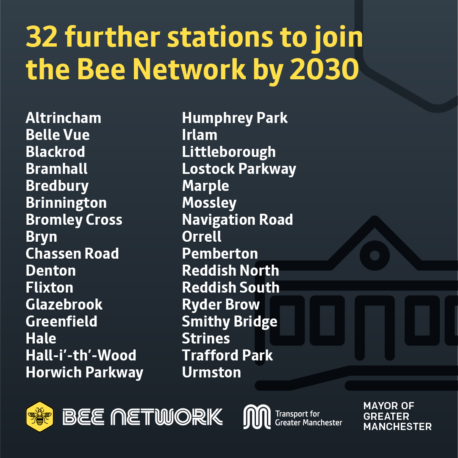Mayor Andy Burnham has set out Greater Manchester’s step-by-step plan to bring rail into the Bee Network by 2028.
It is the next stage in proposals to bring a ‘London-style’ public transport system to Manchester and is intended to boost passenger numbers, drive growth and deliver new homes.
Developed in partnership with the rail industry, Department for Transport (DfT) and Shadow Great British Rail, bosses hope that the improvements will unlock major regeneration and housing opportunities around the city-region’s stations.
Greater Manchester’s proposition is for eight commuter rail lines, covering 64 stations, to be brought into the Bee Network in three phases, including integrated capped fares across bus, tram and train.
Under the plan, the first two lines – connecting Manchester to Glossop and Stalybridge – will join by December 2026. A further 32 stations and all lines within Greater Manchester would join by 2030.
Which stations will join the Bee Network?
Transport for Greater Manchester announced the first stations to join the Bee Network will be:

Appley Bridge
Ardwick
Ashburys
Ashton-under-Lyne
Atherton
Bolton
Broadbottom
Burnage
Castleton
Cheadle Hulme
Clifton
Daisy Hill
Davenport
Deansgate
Dinting
East Didsbury
Eccles
Fairfield
Farnworth
Flowery Field
Gathurst
Gatley
Glossop
Godley
Gorton
Guide Bridge
Hadfield
Hag Fold
Hattersley
Hazel Grove
Heald Green
Heaton Chapel
Hindley
Hyde Central
Hyde North
Ince
Kearsley
Levenshulme
Manchester Airport
Manchester Oxford Road
Manchester Piccadilly
Manchester Victoria
Mauldeth Road
Middlewood
Mills Hill
Moorside
Moses Gate
Moston
Newton for Hyde
Patricroft
Rochdale
Romiley
Rose Mill Marple
Salford Central
Salford Crescent
Stalybridge
Stockport
Swinton
Walkden
Westhoughton
Wigan North Western
Wigan Wallgate
Woodley
Woodsmoor
A further 32 stations are proposed to join the Bee Network by 2030, these are:

Altrincham
Belle Vue
Blackrod
Bramhall
Bredbury
Brinnington
Bromley Cross
Bryn
Chassen Road
Denton
Flixton
Glazebrook
Greenfield
Hale
Hall-i’-th’-Wood
Horwich Parkway
Humphrey Park
Irlam
Littleborough
Lostock Parkway
Marple
Mossley
Navigation Road
Orrell
Pemberton
Reddish North
Reddish South
Ryder Brow
Smithy Bridge
Strines
Trafford Park
Urmston
The approach is hoped to boost the number of trips by train by 1.3 million each year, with more people choosing public transport and more services running later and at the weekend.
Mayor of Greater Manchester, Andy Burnham, said: “Our rail system today is acting as a brake on growth and, as the UK’s fastest growing city-region, Greater Manchester deserves better. We need a railway that is reliable and fully integrated with the rest of the Bee Network to drive growth and deliver new homes with public transport connections on the doorstep.
“Building on the success of bringing our buses back under local control, we’re planning a phased approach to bringing eight commuter lines and their stations into the Bee Network. It will start with lines between the city centre and Glossop and Stalybridge and then expand each year between now and 2028.
“Our plan puts passengers first by delivering a simplified, joined-up public transport network, with better services, stations and overall experience. Only by making travel by train more reliable, simpler, flexible and accessible to everyone, will we convince more people to leave the car at home and make the switch to the Bee Network.
“Delivering change on the railways is notoriously complex, but our phased plan has been drawn up with and has the backing of the rail industry. We’ll continue to work with government – as Great British Rail is established – to support them on the national reform of the railways, enacting the rail powers outlined in the English Devolution White Paper and supporting the Government’s agenda.”
You can read more about the Bee Network’s expansion plans here.
Keep in the know
Be the first to hear about all the best events and news in Manchester.
- Words:
- Bradley Lengden
- Published on:
- Wed 22 Jan 2025